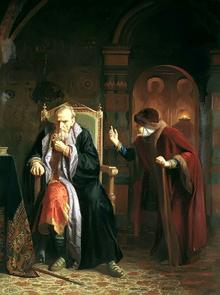After the reign of Vasily Shuisky , the question arose of strengthening the united Russian state. To do this, it was necessary to take several decisive actions - to end decentralization, to form the state apparatus to the end and expand the territory of the country. Vasily III laid the foundation for this process, and his son Ivan, who was only three years old at the time of his father’s death, had to solve the problems.

In 1546, the future Ivan IV reached the age of fifteen (coming of age at that age), and power from his mother completely and completely passed to him. In 1547, he took the title of king. The wedding to the kingdom took place in the Assumption Cathedral. In the same year, a series of fires and a popular uprising took place, which proved that in society there is a confrontation between the boyars and the people. Ivan IV began an intensified struggle against the boyar power, bringing people from other classes closer to himself. The circle of associates was called the “Chosen Council”, which included such persons as Andrei Kurbsky, Metropolitan Makarii and Archpriest Sylvester, Alexei Adashev. They carried out the following reforms, glorifying the reign of Ivan:
1. In 1550, the so-called Code of Law was published - a set of laws that strengthened the royal power.
2. The Strelets army appeared in the army.
3. The finance system has been reformed.
4. The local and central government canceled feedings and introduced a system of orders.
5. The church was reformed.
Changes have led to the fact that in a short time the authority of the government has noticeably grown. The elected Council and its system of government proved to be the most effective. All decisions taken in the 50s of that century were aimed at centralizing the power of the king. Despite the fact that the Elected Council and its reforms had a positive effect on the state and strengthened tsarist power, in 1560 it was dissolved. There were several reasons for this. The tsar ceased to trust his close people, especially when he suspected treason after the flight to Poland of Andrei Kurbsky. Disagreements in views in foreign and domestic politics also increased.
In 1565, Ivan IV established a new sovereign inheritance - the oprichnina, which included economically developed territories.
Here the king formed his government bodies - the Duma, court, orders, as well as the oprichnina army, which later turned into an instrument of
political terror. The elected Council and the oprichnina were endowed with punitive functions, but if the first punishment was only boyars, the oprichnina had power over all classes. As a result of the dominance of the oprichnina in the state, the despotic regime of power of Ivan IV was established. In these harsh years, the tsar received the nickname "Terrible."
However, the reign of terror turned out to be less effective than the Elected Council and its policies. As a result, the king abolished the oprichnina in 1572. After that, the country experienced political and economic crises of the 70s-80s. In addition, there was the ruin of the peasant farms, which were the basis of the country's economy - the Elected Council emphasized them. Oprichnina largely determined the general crisis of power and the coming Time of Troubles.